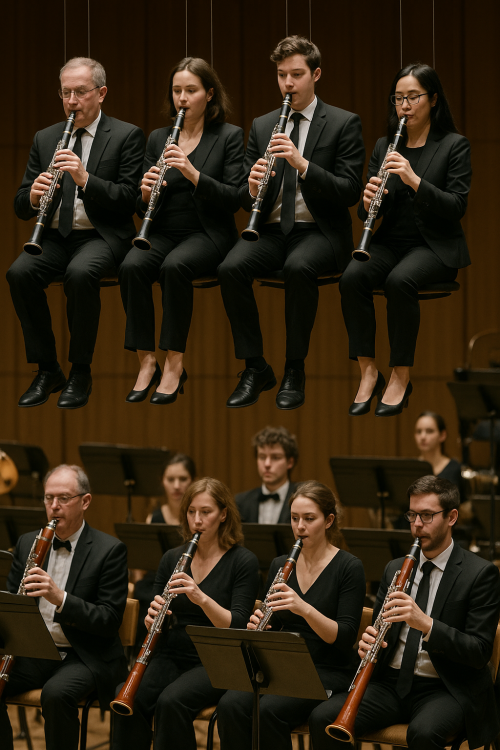
Marius_
Members-
Posts
10 -
Joined
-
Last visited
-
Days Won
4
Marius_ last won the day on July 29
Marius_ had the most liked content!
About Marius_

Profile Information
-
Gender
NA
Recent Profile Visitors
The recent visitors block is disabled and is not being shown to other users.
Marius_'s Achievements
-
Hey Peter, I did a little resolution building with a make-shift notation for the microtonality. I wanted to see if there exists something like a '36-tet dominant chord', something that sounds even more dominant than the normal 12-tet. I didn't find anything at all, but I still think both resolutions sound kinda cool. For the first one I tried resolving with smaller intervals, for the second I used bigger ones. I think you're right about the supermajor chords - I'm not really a fan either. About that E-1/6-flat that was made to sound like a perfect third (just intonated third): I didn't perceive it as such, and I think I know why. A perfect third is a little less than 14 cents lower than 12-tet (according to https://en.wikipedia.org/wiki/Ptolemy's_intense_diatonic_scale), and the third of the dominant only 12. So by lowering that E by 33 cents, you overcompensated, and ended up further away from the perfect third (5 or 9 cents further, but flat instead of sharp). Kind regards, Marius
-
Marius_ started following Rhapsody for Symphony Orchestra , A Moment of Repose , My First Ensemble Piece Ever Recorded - Any Thoughts? and 5 others
-
Hey Peter, This is definitely among the more accessible and coherent-sounding microtonal music I've heard; well done! I probably wouldn't call it poly-microtonal since 12tet is a subset of 36-tet. But then again, is anything poly-microtonal, if you can just define a new tonal system that has all the notes used? I am wondering if it would be possible to create satisfying harmonic movement in this system. I think the major appeal of 12tet music is that you can make really convincing resolutions (like IV-V7-I). Microtonal music / experimental music often lacks those tension releases, in my opinion. Of course if that is your intention, you do you :). For example how would it sound if you changed the E-1/3-flat the 2nd violins keep landing on to a E-1/3-sharp, or even E-2/3-sharp, to emphasize that it's a leading tone? Same goes for b.9-10, 2nd vlns. I would try it myself, but my notation program doesn't really allow microtonal playback and I don't have the patience to manually tune each note in playback lol btw I especially like bar 11-12 with the microtonal echo of the melody, that's really spooky! And the way the 2nd vlns approach that B-1/3-flat on bar 11 is quite sweet. P.S. I'm not really sure but maybe I got 1/3's mixed up with 2/3's - I'm not at all familiar with 36-tet notation
-
My First Ensemble Piece Ever Recorded - Any Thoughts?
Marius_ replied to Mooravioli's topic in Chamber Music
Hey Mooravioli, I like your piece. The harmony is weird and complex. I think for this kind of music the danger is making the harmony too unconventional, which makes the piece hard to listen to. A lot of people that experiment, do it too much. You don't: you keep the listener hooked and curious, and know how to tell a story through chords. Another thing that helps is your use of melodic motives. Really nice! I especially like the resolution and ending from bar 195 onwards. Consider using a tenor saxophone instead of alto, it better suits the melodies you've written. Low notes on sax are often harsh and unpredictable, writing a little higher in the instruments range can give a nicer sound/more freedom to the player to choose the right sound. You can also definitely explore the vibraphone's abilities more. Remember that professionals can play four notes at once! Listen to some bebop vibe players for reference. Also, five sharps (or four for tenor)? why would you do that to anyone? If you raise everything a semitone (Eb major, concert pitch), your players will thank you. As for the genre - this isn't jazz. I would probably call it contemporary classical. If you want to write jazz, listen to the music. If you'd like to write in any style, you need to be familiar with that music. Of course that shouldn't discourage you from writing this music at all! It sounds cool, and that is what matters. I just wanted to say, if you call this jazz and show it to a jazz musician, they will look at you like "🙂 that is really ~interesting~ jazz 🙂". For improvisation, your best bet is to write chord symbols and let one player completely free, like in traditional jazz songs, because that is what players are used to. Saying 'feel free to improvise' and 'improvise less' is very vague, and may not give the effect you want. What you could say is 'feel free to embellish' or something, if that's what you had in mind. In general: if you don't want someone to play the written notes, don't write the notes... -
Hey Alex, Except for those balance issues, I cannot hear a problem with the audio either. Do you still notice it in the exported and uploaded MP3 files, or is it just in the program itself? When I tried MuseSounds I had a lot of problems with it (including 'stuttering' and distortion), and I think that was because my potato pc just couldn't handle the program... But I'd imagine (didn't try it myself though) these issues would disappear upon exporting the audio. I should say I tried MuseSounds at its very first release (I believe 1-2 years ago), and my experience might've been due to a bug that has been fixed since. Anyway, I was so horrified that to this day I haven't tried using it again, so this might not be an issue anymore.
-
Echoes of Flame - Concert Band
Marius_ replied to NicholasG's topic in Orchestral and Large Ensemble
Hey Nicholas, I like your piece a lot! It sounds epic, and you take your time with each theme, which makes it sound coherent and easy to listen to. I don't have any experience writing for large ensembles, so I thought I'd only give feedback on your brass writing (I play the trumpet myself). First of all, in bar 21 consider raising the second trumpet an octave. That will make it easier for the first trumpet to hit his note: it is easier to play when being 'carried' by the rest of the section - and that two-octave gap is to large to give that effect. (As written it will sound like a solo instead of team work.) My teacher used to say: 'Trumpet players are surfers. We surf on sound.' At certain points in the score you write divisi for the trumpets, horns and first trombone - but you assigned three players to each part (in the preface)!! Which of the two voices should get two players? Either split up in three parts or make a note in their score, telling them what to do. But also consider that your brass section is humongous (A dozen players on trumpet and horn): You can change the parts to avoid all divisi. E.g. after bar 102 you could give the trumpets the root and fifth and the horns the root and third. In Musescore this will sound just the same, but when played by a real orchestra all voicings sound distinctly different. Not having divisi also is less confusing - especially if your players don't get (many) rehearsals. Btw that 1.5 octave jump in bar 106, first trumpet, looks really scary... Lastly, from that same bar 106 your trumpets and horns are playing fortissimo - which basically means 'as loud as possible'. Therefore the four (!) crescendo's you write later in the part won't have any effect... Either tell them to take back before each crescendo, or don't write them at all. That'll conclude my oddly-specific-feedback : ) . I should tell you again - I'm no pro at all, and your writing already is really good. Don't take this as harsh criticism: I'm just better at pointing out imperfections than giving elaborate compliments :)). I really enjoyed listening to your piece! Kind regards, Marius -
The Echos of Flame - Work in progress
Marius_ replied to NicholasG's topic in Orchestral and Large Ensemble
Also when the brass is playing the melody I would try to harmonise it. That'll make it sound more 'full'. Although that is also a neat card to only pull later on in the piece, if that melody returns. This also goes for woodwinds, but it is less important there, cause of the different textures the instruments have; when they are playing in unison it'll probably sound more varied already. Brass sounds really epic but also kinda like a sine wave imo... Especially when they are a bit pitchy -
The Echos of Flame - Work in progress
Marius_ replied to NicholasG's topic in Orchestral and Large Ensemble
Alternative option not bad either. Those things below are supposedly bassoons... Your piece sounds really cool. I'd love to hear it when it is finished 🙂 -
Nice piece! It makes me think of the C418 minecraft soundtrack. Yes, it does feel static, but personally I don't mind that at all. Although the best moments are when you break that staticness, like in bar 30-something with the sixtuplet. I like how you - when using the same chord for two successive bars - thin out / change the texture. Well done! Kind regards, Marius
-
Quick little harmony/counter-point mini-challenge :)
Marius_ replied to UncleRed99's topic in Challenges
Made this account just so I could upload this and remind y'all never to end in minor : ) Also accidental Shostakovich in bar 3. -
Hi! I'm new as well. I really like your piece - it has wonderful harmonic turns, it feels very well thought out. I especially like the really smooth key changes, and the part after b.24. The melodies are less recognisable, but I think it kinda suits the style. I think the playability is something you could work on (if you ever want a real orchestra to play it). First of all I'd try to change the key: probably to Eb and D instead of Db and C. You'll run into range issues doing that, but no-one likes playing with 5 flats. Whereas 3 flats is really nice for the winds and two sharps are nice for strings. Furthermore you might want to keep in mind that ppl need to breathe.. I'm mostly talking about the last note in the horns - I think it's possible, but it is a veeeery long note and also playing that pianissimo will only make it worse - you risk the sound getting quite shakey bc they'll be out of breath, and that will be very audible because no-one else is playing. Also the accel. from b.30 onward will be difficult to keep consistent. When performed it won't be as gradual as when done by a computer. Idem for other long gradual tempo changes. But for a professional orchestra these things would be entirely possible. And musically it's really good. I should say I don't have much experience reading scores or conducting so I don't know if this would be balanced at all - although I think so. My favourite moment is b.55 - really nice melody there! Kind regards Marius P.S.: Gershwin was really obvious. I think I heard some Sibelius 2 (mvt. 4) with that syncopated background and rising melody, but I'm not really sure. I didn't catch the third quote.







